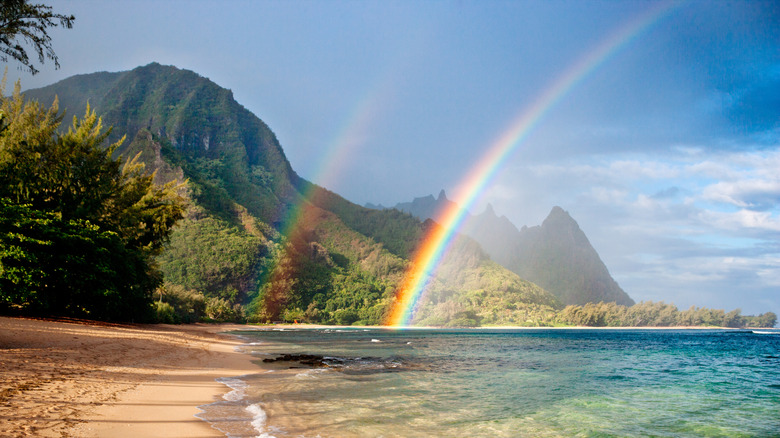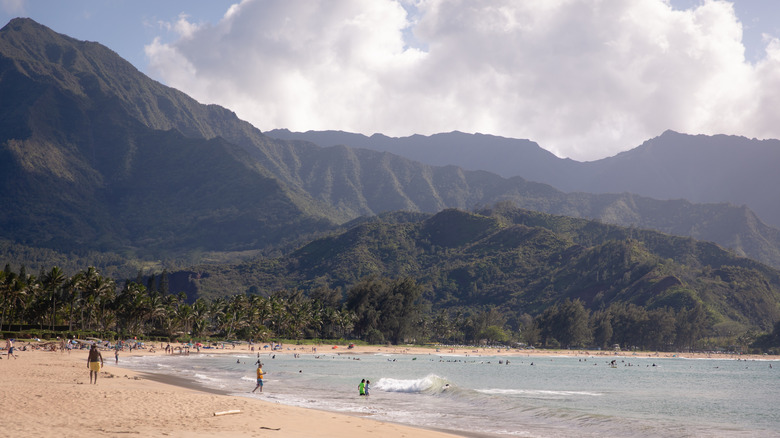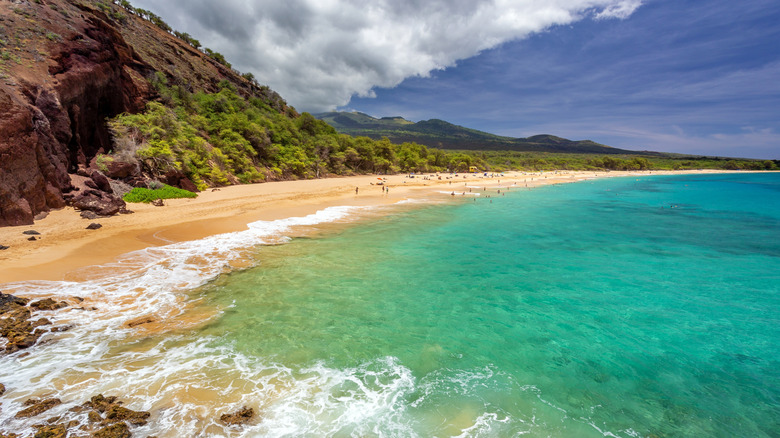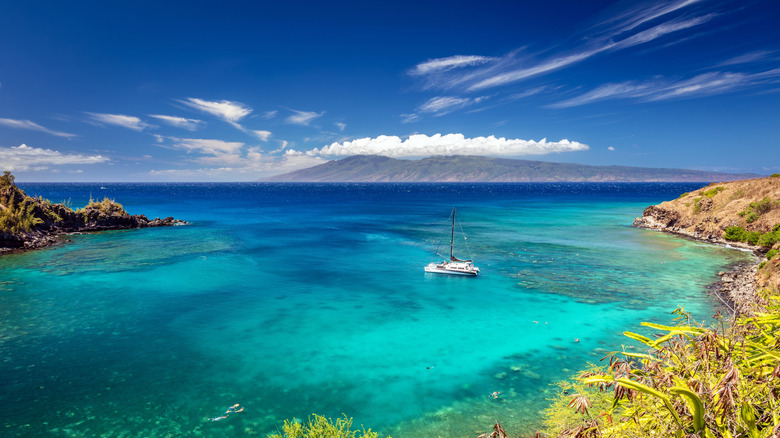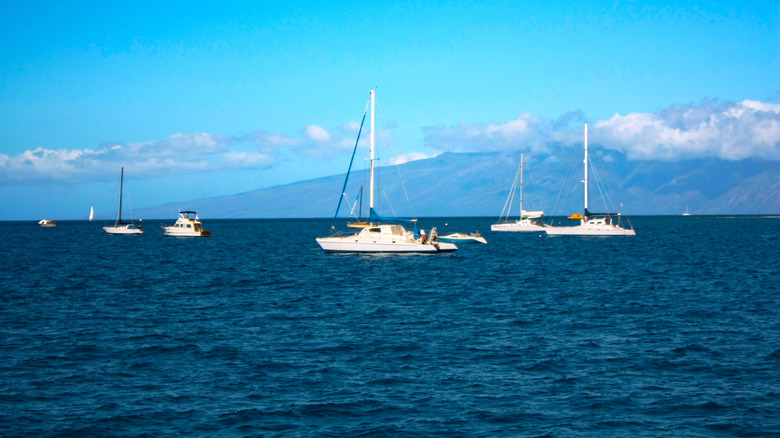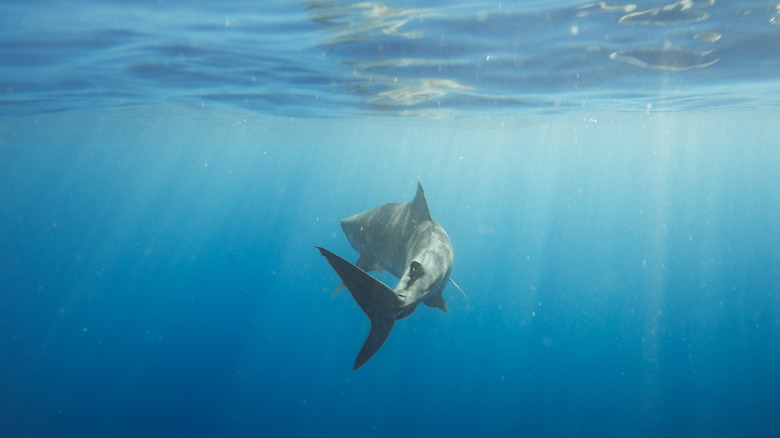The Most Shark-Infested Beaches In Hawaii That'll Have You Reconsidering Your Next Swim
There are many reasons why Hawaii is one of the most popular travel destinations and one of the most popular honeymoon destinations, from its beautiful, sunny weather to its lush natural environment and many gorgeous sandy beaches. However, as relaxing and refreshing as most Hawaiian beaches are, some are heavily populated by sharks, which makes swimming in them potentially dangerous. Since 1980, Hawaii has had 177 shark attacks, with October 2013 registering the highest number of attacks in one month (via American Surf Magazine).
While shark attacks are possible across many Hawaiian Islands, Maui and Oahu rank above others for the highest number of incidents, with Maui at the top. Interestingly, the two islands are the most popular Hawaiian tourist destinations. Most shark-related incidents in Maui reportedly occur along the island's west and southern coasts, presumably due to the shallow waters containing a lot of marine life. Regarding Oahu, based on the record of incidents, it is believed that most shark activity occurs on the island's north and offshore. While Hawaii's Department of Land and Resources (DLNR) has emphasized that the possibility of a shark bite is rare, if the possibility still concerns you, there are a few beaches that it would be wise to avoid.
Hanalei Bay — Kauai
Located on Kauai's north shore, Hanalei Bay is one of the island's most popular spots for several reasons, including its three stunning sandy beaches: Black Pot Beach Park, Wai'oli Beach Park, and Waikoko Beach. The area is so popular that it has even made its Hollywood debut, being featured in films like "The Descendants" and "South Pacific." Each beach area boasts a unique slice of natural beauty, which the community of Hanalei is known for. Black Pot is the perfect spot for enjoying a breathtaking Hawaiian sunset. Wai'oli Beach is ideal for a quiet day of lounging amongst its many pine trees, and Waikoko Beach is more secluded and appealing to surfers.
Unfortunately, as beautiful and popular as all three beaches are, the area is renowned for its large shark population. A significant contributing factor to the prevalence of sharks is the bay's proximity to marine life that the predators feed on, including turtles and seals. Although there hasn't been a significant number of shark attacks at the bay's beaches, their presence is plentiful enough that caution warnings are regularly placed around the area. The authorities also keep a close eye, initiating beach closures whenever necessary.
Makena Beach — Maui
Affectionately referred to as Big Beach due to being one of the largest beaches on the island, Makena Beach is both a swimmers' and snorkelers' paradise with its mostly untouched beauty. It's even considered one of Maui's best beaches. While less popular than some more tourist-friendly beaches, such as Kā'anapali, Makena Beach offers visitors a quiet spot to enjoy stunning views of Maui. Unfortunately, it is also located on Maui's southwestern shore, where a lot of the island's shark activity occurs. As a result, the popular beach attracts its fair share of marine predators, particularly tiger sharks.
Any shark sightings result in the temporary closure of the beach and its surrounding areas. There have been three total deadly shark incidents since 2013, including when a local fisherman was killed by a shark attack while kayaking. Overall, shark attacks are rare, but local authorities still encourage visitors to exercise caution when in or near the waters.
Honolua Bay — Maui
Honolua Bay is considered one of the best places in Hawaii for surfers to capture an amazing wave. Its popularity as a surf has been prevalent since the mid-1900s and continues today. However, it is also one of the most shark-infested beach areas. Honolua holds the unfortunate distinction of being the location where one of Hawaii's fatal shark attacks occurred. The incident took place in the early morning on December 10, 2020, when a surfer was attacked by a 14-foot tiger shark and later died at the hospital.
One significant reason why the waters of Honolua Bay appeal to sharks is because of the plentiful marine life it holds. It is also why the bay is one of the island's most popular snorkeling and diving spots. With parrotfish, angelfish, sea turtles, and more, Honolua Bay is a stunning spot for capturing glimpses of various sea creatures. Unfortunately, they are also an excellent food source for sharks.
Kahului Harbor — Maui
Kahului Harbor is one of the busiest beach areas in Maui, largely because it is predominantly used as a port for commercial cruise lines like Carnival and Norwegian and is located near the Maui International Airport. It is also a very popular spot for water sports enthusiasts who enjoy aactivities such as kitesurfing, paddleboarding, surfing, and more. Kahului Harbor unfortunately also encounters a high share of sharks, largely due to its location along Maui's north shore.
Among other factors, the area has a significant protected ocean shelf, which makes it an appealing dwelling spot for tiger sharks. Most shark activity typically occurs during October, since this corresponds with the sharks' pupping and migration seasons. The bay is used for so many activities, often causing a large crowd of people, so it is unsurprising that the rate of reported shark appearances is much higher than in other locations.
Mālaekahana Beach — Oahu
Oahu is a close second to Maui for shark activity in Hawaii, and one area with the highest concentration is Mālaekahana Beach, located on the island's north shore. Although Mālaekahana Beach is one of the island's less popular beaches, it appeals to those seeking a quieter, more relaxed venue. It is so quiet and laid-back that it is also popular for its surrounding campground, which offers a variety of accommodations and activities for those seeking the perfect camping experience (although it has been closed for renovations since 2023). The stunning beach adds to the experience, as you can go swimming, paddling, kayaking, and more.
Unfortunately, the beach's reputation for shark activity, including the tragic death of surfer and actor Tamayo Perry in 2024, has made many cautious about visiting it. Following the tragic incident, shark warning signs were quickly erected across Mālaekahana Beach and other popular Oahu beaches. As frightening as the possibility of encountering a shark is, the reality is that the chances of being attacked by a shark are low. There are still many worthwhile reasons to visit these Hawaiian beaches, but it is essential to exercise a little caution.
